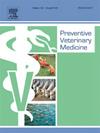阿根廷牧场奶牛群小牛从出生到断奶死亡的相关危险因素
IF 2.4
2区 农林科学
Q1 VETERINARY SCIENCES
引用次数: 0
摘要
本研究的目的是1)估计阿根廷奶牛群从出生到断奶的死亡率,2)确定相关的危险因素。2019年11月至2020年3月期间,在阿根廷最重要的乳制品地区之一进行了一项横断面研究。共有77家奶牛场参与了这项研究。潜在的解释变量是从小牛饲养员回答的清单问卷中获得的。使用二项分布(前一年死亡的小牛数量/去年出生的小牛总数)和logistic关联函数的广义线性模型对奶牛死亡率进行建模。小牛平均死亡率为10.1 %(95 %CI 9.6-10.6 %)。犊牛死亡率的相关危险因素有工作经验、肚脐消毒、气候保护、初乳管理、断奶决策、奶牛师数量和每头奶牛活产小牛的比例。工作经验越少,小牛死亡率越高(优势比- or - = 6.25;95 %CI 4.17-10),未进行肚脐消毒(OR = 1.75;95 %CI 1.50-2.02),气候保护较少(极端天气对小牛的保护,OR = 1.66;95 %IC 1.40-1.19),初乳管理较差(OR = 2.17;95 %IC 1.64-2.94),断奶基于小牛的大小(OR = 1.22;95 %IC 1.05-1.41),哺乳小牛的数量减少(OR = 0.84;95 %CI 0.75-0.95),每头奶牛活产小牛的比例较低(OR = 0.63;95 %可信区间0.38 - -1.06)。综上所述,阿根廷奶牛的死亡风险与奶牛饲养员(数量和工作经验)、产犊管理(初乳管理、断奶方法、气候保护和肚脐消毒)和奶牛场效率(每头奶牛活产洞数)等不同方面相关。本文章由计算机程序翻译,如有差异,请以英文原文为准。
Risk factors associated with calf mortality from birth to weaning in pasture-based dairy herds in Argentina
The aim of this study was to 1) estimate dairy calf mortality from birth to weaning in Argentinean herds, and 2) identify associated risk factors. A cross-sectional study was conducted between November 2019 and March 2020 in one of Argentina's most important dairy regions. A total of 77 dairy farms were included in the study. Potential explanatory variables were obtained from a checklist questionnaire answered by calf nursers. Dairy calf mortality was modelled using a generalized linear model applying a binomial distribution (number of calves that died in the previous year / total number of calves born alive during the last year) and logistic link function. The mean calf mortality was 10.1 % (95 %CI 9.6–10.6 %). The associated risk factors of calf mortality were work experience, navel disinfection, climate protection, colostrum management, weaning decisions, the number of calf nursers, and the ratio of live-born calves per cow. Calf mortality is higher when there is less work experience (Odds Ratio -OR- = 6.25; 95 %CI 4.17–10), no navel disinfection is performed (OR = 1.75; 95 %CI 1.50–2.02), there is less climate protection (extreme weather protection of the calves, OR = 1.66; 95 %IC 1.40–1.19), colostrum management is poor (OR = 2.17; 95 %IC 1.64–2.94), weaning is based on calf´s size (OR = 1.22; 95 %IC 1.05–1.41), there is a reduced number of calf nursers (OR = 0.84; 95 %CI 0.75–0.95), and the ratio of live-born calves per cow is low (OR = 0.63; 95 %CI 0.38–1.06). In summary, the mortality risk of dairy calves in Argentina was associated with different aspects related to the calf nursers (number and work experience), calving management (colostrum management, weaning method, climate protection, and navel disinfection), and the efficiency of the dairy farm (ratio of live-born caves per cow).
求助全文
通过发布文献求助,成功后即可免费获取论文全文。
去求助
来源期刊

Preventive veterinary medicine
农林科学-兽医学
CiteScore
5.60
自引率
7.70%
发文量
184
审稿时长
3 months
期刊介绍:
Preventive Veterinary Medicine is one of the leading international resources for scientific reports on animal health programs and preventive veterinary medicine. The journal follows the guidelines for standardizing and strengthening the reporting of biomedical research which are available from the CONSORT, MOOSE, PRISMA, REFLECT, STARD, and STROBE statements. The journal focuses on:
Epidemiology of health events relevant to domestic and wild animals;
Economic impacts of epidemic and endemic animal and zoonotic diseases;
Latest methods and approaches in veterinary epidemiology;
Disease and infection control or eradication measures;
The "One Health" concept and the relationships between veterinary medicine, human health, animal-production systems, and the environment;
Development of new techniques in surveillance systems and diagnosis;
Evaluation and control of diseases in animal populations.
 求助内容:
求助内容: 应助结果提醒方式:
应助结果提醒方式:


